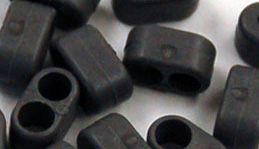Metal injection molding, or MIM, is a manufacturing process which combines the versatility of plastic injection molding with the strength and integrity of machined, pressed or otherwise manufactured small, complex, metal parts. The process involves combining fine metal powders with binders which allow the metal to be injected into a mold using standard plastic injection molding machines.
After the part is molded and before the binders are removed, the part is referred to as a 'green part'. The next step is to remove the primary binder. The resultant metal part, ‘brown part’, is sintered at temperatures great enough to bind the particles but not melt the metal and deforming the part. The products of metal injection molding are up to 98% as dense as wrought metal and used in an increasingly broad range of applications. The advantage of metal injection molded parts is that very complex parts that are difficult or even impossible to otherwise fabricate can be manufactured in large quantities.
Advantages of Debinding with Supercritical CO2 (SC-CO2 )
- Faster debinding
- Because SC-CO2, unlike a liquid, has no surface tension, it permeates deeper into the part and dissolves the primary binder quicker and more completely
- Since the debinding is faster, larger parts can be economically fabricated
- Environmentally friendly
- NO VOC emissions
- No prohibition by the environmental treaties
- No increase in greenhouse gases. The supercritical debinding uses existing CO2, no additional CO2 is created.
Traditional debinding methods such as thermal debinding, water solubilization, solvent solubilization, and catalytic debinding are
- environmentally unfriendly due to high VOC emissions
- may use solvents that are scheduled to be outlawed by the Montréal protocol
- have excessively long debinding times.
